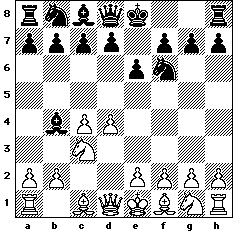My friend Mike and I went to see this game.
Kasparov vs. Anand World championshipThey played at the top of the World trade center,
observation deck

in a sound proof, glass enclosed space.
You could sit and watch them think, or go off
to the side where Grandmasaters where discussing all the possible moves.
Here's the game;
[Event "Ch World (match) (PCA)"]
[Site "New York (USA)"]
[Date "1995.??.??"]
[EventDate "?"]
[Round "14"]
[Result "1-0"]
[White "Kasparov Gary (RUS)"]
[Black "Anand Viswanathan (IND)"]
[ECO "B01"]
[WhiteElo "?"]
[BlackElo "?"]
[PlyCount "82"]
1.e4 d5 2.exd5 Qxd5 3.Nc3 Qa5 4.d4 Nf6
5.Nf3 c6 6.Ne5 Be6 7.Bd3 Nbd7 8.f4 g6
9.O-O Bg7 10.Kh1 Bf5 11.Bc4 e6 12.Be2 h5
13.Be3 Rd8 14.Bg1 O-O 15.Bf3 Nd5 16.Nxd5 exd5
17.Bf2 Qc7 18.Rc1 f6 19.Nd3 Rfe8 20.b3 Nb6
21.a4 Nc8 22.c4 Qf7 23.a5 Bf8 24.cxd5 cxd5
25.Bh4 Nd6 26.a6 b6 27.Ne5 Qe6 28.g4 hxg4
29.Nxg4 Bg7 30.Rc7 Ne4 31.Ne3 Bh3 32.Rg1 g5
33.Bg4 Bxg4 34.Qxg4 Qxg4 35.Rxg4 Nd6 36.Bf2 Nb5
37.Rb7 Re4 38.f5 Rxg4 39.Nxg4 Rc8 40.Rd7 Rc2
41.Rxd5 1-0
 (Reuben Fine)
(Reuben Fine)









 Chess entymology:
Called by the Hindus cheturanga (the four angas)âi.e. the four members of the armyâviz. elephants, horses, chariots, and foot-soldiers; called by the ancient Persians chetrang. The Arabs, who have neither c nor g, called it shetranj, which modern Persians corrupted into sacchi, whence the Italian scacchi, German schach, French echec, our chess.
Chess entymology:
Called by the Hindus cheturanga (the four angas)âi.e. the four members of the armyâviz. elephants, horses, chariots, and foot-soldiers; called by the ancient Persians chetrang. The Arabs, who have neither c nor g, called it shetranj, which modern Persians corrupted into sacchi, whence the Italian scacchi, German schach, French echec, our chess.
